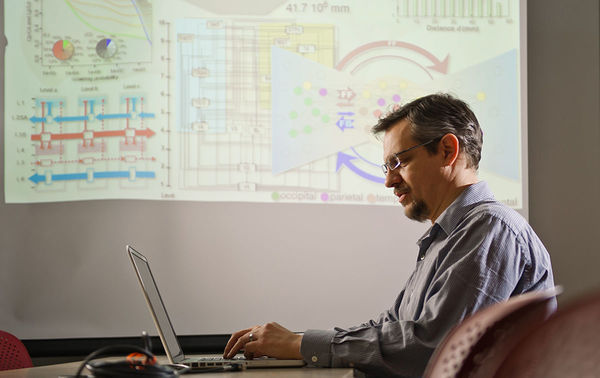

Zoltán Toroczkai, professor in the Department of Physics, will be working with NTT Research, Inc., to conduct joint research into the limits of continuous-time analog computing.
The five-year agreement between Notre Dame, other top universities, and NTT Research will focus on improving the company’s Coherent Ising Machine (CIM), an optical device they have built that exhibits characteristics related to those of analog or quantum computers.
“This project with NTT Research is an exciting opportunity to engage in basic research that will bear upon the future of computing,” said Toroczkai, who is also a co-director of Notre Dame’s Center for Network and Data Science. “It is a field very ripe for opportunities, and with a lot of unsolved questions.”
Digital computers perform most tasks well, from word processing to certain computations to graphic arts. But the digital system that relies on the binary code of 1s and 0s isn’t ideal for solving every problem. For problems with many variables or people, such as scheduling a “traveling salesperson” trip in which a person must visit several locations and return to her own city at the end of the trip – with great efficiency – or determining which medications or combinations of therapies can work with the fewest side effects to cure a disease, digital computers can take far too long for them to be practical to solve such problems, especially if they are large. Some analog machine designs used as special-purpose devices show an early promise to beat digital machines at such tasks.
However, analog and quantum computers are prone to “noise,” or disturbances in signals, that are difficult to control. Also, unlike digital computing which has a long history in algorithm development, analog computer algorithms lack a similar knowledge base and are more difficult to design. And that’s an area where NTT Research will lean on Toroczkai’s expertise with mathematical models, also called analog solvers, that can potentially find the best solutions to the problems the CIM is asked to solve.
His work will explore the theoretical limits of analog computing and focus on several approaches to achieving improved performance while controlling the precision of the computation, or, in the context of the CIM, achieving an improved optical pulse amplitude landscape.
“If you’re seeking an optimal system for computation, or information processing, it is difficult to beat the brain, which is a hybrid system with both an analog and digital component; an amazing system that we can only learn from,” Toroczkai said, adding that the CIM will act as a neural network, not unlike the brain.
In addition to Toroczkai’s lab, other collaborators with NTT Research project include the California Institute of Technology (Caltech), Cornell University, Massachusetts Institute of Technology (MIT), Stanford University, Swinburne University of Technology and the University of Michigan. Also, researchers from the NASA Ames Research Center in Silicon Valley, and the private company, 1Qbit in Canada, will contribute.
“We’re very excited to have the University of Notre Dame and Professor Toroczkai, a specialist in analog computing, join our growing consortium of researchers engaged in rethinking the limits and possibilities of computing,” said NTT Research PHI Lab Director Yoshihisa Yamamoto. “We see his work at the intersection of hard, optimization problems and analog computing systems that can efficiently solve them as very promising.”
Originally published by at science.nd.edu on September 16, 2020.